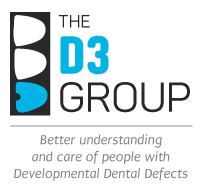D3G SPECIALISTS GUIDE FOR DIAGNOSING MOLAR HYPOMIN
Specialist Stuff
Again building on the Basic Guidelines, here we aim to define the key "shades-of-grey" questions, as may be asked by experienced GPs and paediatric dental specialists, and as could be used in experimental design by researchers. As a starting point, please consider existing guidelines (summaries below) before proceeding to rethink the issues through in a research-friendly way.
Existing Diagnosis Guidelines from around the world
D3G Down Under
- Grace Suckling's DDE index (Suckling et al. 1976, 1984, 1985, 1987, 1998)
- Louise Messer, Melbourne (Chawla 2008)
Europe
- • Proceedings of EAPD meeting in Athens 2003 (Weerheijm et al., 2003)
- • EAPD consensus 2010 (Lygidakis et al., 2010)
FAQS
A. Diagnosing at tooth level
Q A1: Is the description "demarcated opacities" always valid for Molar Hypomin?
Subquestions:
- do all opacities have clearly-demarcated borders?
- are all lesions densely opaque, as distinct from mottled or diffuse?
- disregarding causation, can Hypomin teeth have diffuse as well as demarcated opacities?
Additional key literature:
- Grace Suckling – as above, plus Suckling 1989
Research needs:
- develop additional clinical criteria to define Molar Hypomin (vs. fluorosis & other D3s)
- is there a place for molecular diagnostics, which in principle are now within reach? (Perez, 2020)
Q A2: Does the cuspal location of lesions hold most diagnostic value?
Subquestions:
- are Hypomin lesions (opacities & derivatives) always located in the occlusal half?
- do the exceptions hold diagnostic value (and so rate a mention)?
- is it better to focus on occlusal half to avoid confounding with cervical caries?
- is it better to overlook occlusal lesions to avoid confounding with normal pit/fissure caries?
Additional key literature:
- ??
Research needs:
- do cuspal lesions hold highest diagnostic value?
Q A3: Does spatial patterning of lesions hold diagnostic value?
Subquestions:
- do Hypomin lesions have distinctive topographical features (shape, relative positions)?
- do all lesions exhibit a chronological pattern across affected teeth?
- ??
Research needs:
- explore topographical characteristics of Hypomin lesions as a diagnostic aid
B. Diagnosing at mouth level
Q B1: How important is the number of involved molars and asymmetry?
Subquestions:
- is asymmetry or "sporadic phenotype" (left/right, maxilla/mandible) pathognomonic for Molar Hypomin?
- should sporadic phenotype receive more attention as a key diagnostic feature?
Additional key literature:
- Asymmetric presentation in 11-year olds (Biondi, 2017)
Research needs:
- what percentage of Molar Hypomin cases involve asymmetry at mouth and tooth levels? (cf. >50% predicted)
Q B2: Does incisal involvement strengthen the diagnosis?
Subquestions:
- might this chronological association help invoke a causal insult?
- should incisal cases lacking molar involvement be disregarded as a separate entity?
- distinguishing Incisor and Molar Hypomin (Balmer, 2015)
Research needs:
- disregarding causation, are demarcated opacities pathologically equivalent in Incisor Hypomin & Molar Hypomin?
Q B3: Does co-involvement of other teeth weaken the diagnosis?
Subquestions:
- should Molar Hypomin be conceptually limited to chronologically-linked teeth (6s/Es/incisors)?
- could co-involvement of later-developing teeth reflect later insults?
Additional key literature:
- ??
Research needs:
- are "other demarcated opacities" fundamentally equivalent to those in Molar Hypomin?
C. Differential diagnoses
Q C1: Can Molar Hypomin and fluorosis appear in the same mouth?
Subquestions:
- is it common to see (supposedly) fluorotic incisors together with Hypomin Molars?
- can fluorosis and Hypomin be distinguished on the basis of dental symmetry (sporadic phenotype)?
- should possible co-occurrence of fluorosis impede a Molar Hypomin diagnosis?
Additional key literature:
- ??
Research needs:
- robust criteria to distinguish Hypomin and fluorosis, besides demarcated/diffuse opacities?
- again, is there a place for molecular diagnostics (which in principle are now within reach)?
Q C2: Can Molar Hypomin and fluorosis appear in the same tooth?
Subquestions:
- can fluorosis be distinguished from white/mild Molar Hypomin lesions reliably?
Additional key literature:
- Grace Suckling – as above, plus Suckling 1989
Research needs:
- develop additional clinical criteria or tools to distinguish Molar Hypomin from fluorosis
Q C3: Can caries in Hypomin enamel be distinguished from caries in normal enamel?
Subquestions:
- does the mineral deficiency and porosity of Hypomin enamel lead to a distinctive caries?
- can occlusal caries in Molar Hypomin be distinguished from normal pit/fissure caries?
- can mesial/distal caries in Molar Hypomin be distinguished from normal interproximal caries?
- are caries-progression rates in Molar Hypomin faster than in normal teeth (how much)?
Additional key literature:
Research needs:
- is caries progression in Molar Hypomin associated with distinctive plaque characteristics?
Q C4: How best can Molar Hypomin breakdown be distinguished from Hypoplasia?
Subquestions:
- do all "Hypoplastic lesions" (localised hypoplasias) have visibly-rounded & regular margins?
- during breakdown, do all Molar Hypomin lesions have visibly-sharp & irregular margins?
- are most Hypoplasias relatively static (resistant to degradation) post-eruptively?
- are the rates of post-eruptive degradation a key discriminator for Hypomin/Hypoplasia?
- do Hypoplastic lesions often appear on the same tooth as Hypomin lesions?
- can Hypoplasia and Hypomin be distinguished on the basis of sporadic phenotype?
- should possible co-occurrence of Hypoplasia impede a Molar Hypomin diagnosis?
- is it practicable to verify that Hypoplasias existed before emergence, as per the definition?
Additional key literature:
- ??
Research needs:
- develop additional clinical criteria and tools to distinguish Molar Hypomin from Hypoplasia
Current D3G Research
Clinical research
A clear clinical need exists to strengthen the diagnostic parameters for Molar Hypomin. One enticing possibility is to harness modern diagnostic technologies such as light-induced fluorescence (article), should studies extend their utility from caries to Hypomin.
Basic and applied science
Strong potential exists to supplement current clinical parameters (e.g. visual, X-ray) with more-stringent diagnostic tests. Such tests might be based on distinctive biophysical or biomolecular properties of affected teeth. Ultimately, by making diagnosis accurate and simple, new clinical tests may lead to better treatment solutions on the lifelong term.
Current projects at D3G
Diagnosis-related areas being researched by D3G teams include:
- laser fluorescence as a diagnostic tool (article) – Drummond/Swain team
- diagnostic & severity index for Molar Hypomin (article) – Messer/Manton/D3G team
- Hypomin diagnosis based on protein profiles (Mangum 2010, Williams 2020, Perez 2020) – Hubbard/D3G team
- porosity indicators for Hypomin enamel – Hubbard group

